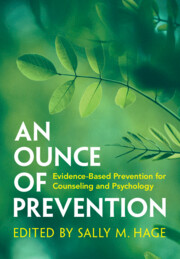Book contents
- An Ounce of Prevention
- An Ounce of Prevention
- Copyright page
- Dedication
- Contents
- Figures
- Contributors
- Acknowledgments
- Part One A Foundation in Prevention
- Part Two Prevention with Children and Youth
- Part Three Prevention with Emerging Adults
- 8 Ecological and Developmental Approaches to Reducing Substance Use and Related Harms among Emerging Adults
- 9 Building Action from Awareness Movements
- 10 Best Practices in Building Comprehensive Strategies to Prevent Sexual Violence for College-Age Students
- 11 College: The Window of Opportunity
- Part Four Across the Lifespan: Adults and Families
- Part Five Closing
- Index
- References
9 - Building Action from Awareness Movements
from Part Three - Prevention with Emerging Adults
Published online by Cambridge University Press: 14 November 2024
- An Ounce of Prevention
- An Ounce of Prevention
- Copyright page
- Dedication
- Contents
- Figures
- Contributors
- Acknowledgments
- Part One A Foundation in Prevention
- Part Two Prevention with Children and Youth
- Part Three Prevention with Emerging Adults
- 8 Ecological and Developmental Approaches to Reducing Substance Use and Related Harms among Emerging Adults
- 9 Building Action from Awareness Movements
- 10 Best Practices in Building Comprehensive Strategies to Prevent Sexual Violence for College-Age Students
- 11 College: The Window of Opportunity
- Part Four Across the Lifespan: Adults and Families
- Part Five Closing
- Index
- References
Summary
College students disproportionately live with increased risk and burden of mental illness and suicide, yet most students do not access formal campus mental health services. One part of the solution to this problem has been the Bandana Project (BP), a peer-led mental health awareness and suicide prevention program. The program leverages the members’ vested interest in peer support, mental health promotion, and suicide prevention efforts to foster connectedness and offer alternative support to those who may be struggling. Education offered through the program orients members to relevant, evidence-based suicide prevention strategies and to various mental health resources. The program may contribute to reducing the burden of suicide and mental illness on campuses and help make college communities more supportive of students’ mental health. Further development, applications, and limitations of this program on the college campus setting – and beyond – are discussed.
- Type
- Chapter
- Information
- An Ounce of PreventionEvidence-Based Prevention for Counseling and Psychology, pp. 175 - 196Publisher: Cambridge University PressPrint publication year: 2024

